New data from fossil shows changes in axial skeleton that foreshadow the evolution of walking
Before the evolution of legs from fins, the axial skeleton—including the bones of the head, neck, back and ribs—was already going through changes that would eventually help our ancestors support their bodies to walk on ...








